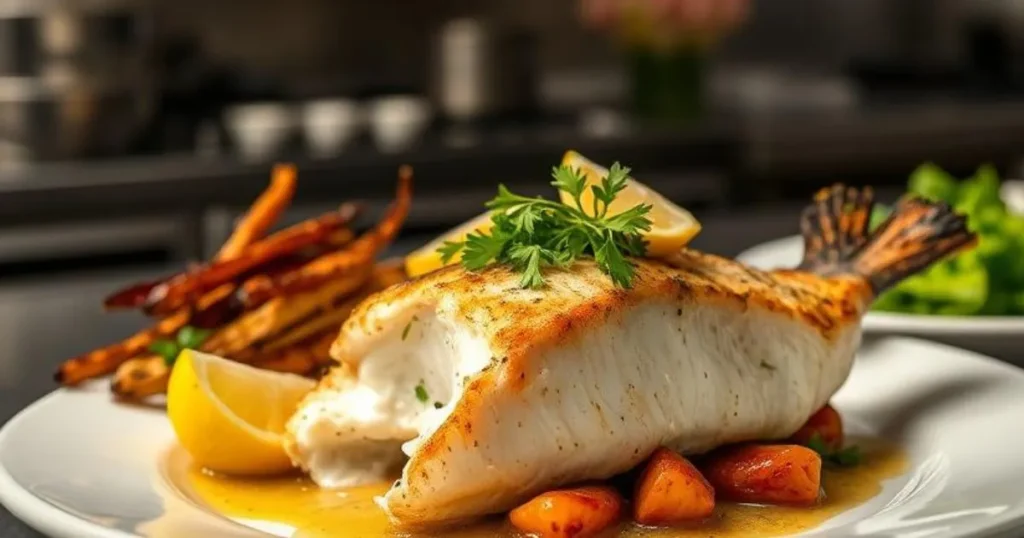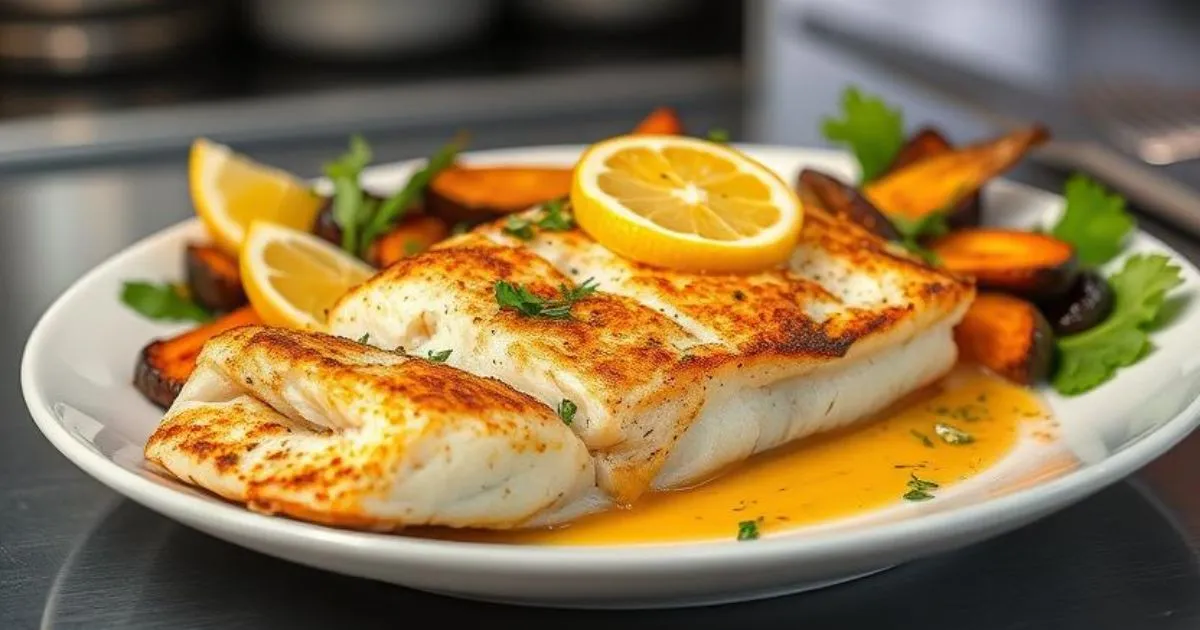The Best Way to Cook Lingcod: Tips and Tricks for a Perfect Dish Every Time
Table of Contents
If you’ve ever tasted lingcod, you know it’s a special kind of fish. With its mild flavor, firm texture, and versatility in cooking, it’s a perfect choice for a variety of recipes. Whether you’re a seafood lover or just trying out something new, cooking lingcod the right way will elevate your meal and leave your guests impressed. But how do you make sure your lingcod turns out perfectly every time? That’s where this guide comes in. We’ve compiled expert tips, tricks, and recipes to help you achieve the best lingcod dishes, no matter your cooking skill level. Let’s dive in and discover the secrets to cooking lingcod to perfection!
Why Lingcod is a Great Choice for Your Next Meal
Lingcod is often praised for its mild, slightly sweet flavor and firm, flaky texture. Unlike some fish that can be overly “fishy,” lingcod offers a much more subtle and delicate taste, making it an ideal option for people who may not typically enjoy seafood. Additionally, lingcod is incredibly versatile—whether you prefer grilling, pan-searing, or baking, it performs well with a variety of cooking methods.
Key Benefits of Lingcod:
- Mild Flavor: Ideal for those who prefer a lighter fish taste.
- Firm Texture: Holds up well during cooking, making it perfect for grilling or pan-searing.
- Healthy Choice: Rich in protein, omega-3 fatty acids, and low in fat, making it a nutritious option.
- Sustainable: Lingcod is caught in a sustainable manner, so you can feel good about your choice for both taste and the environment.
By choosing lingcod, you’re not only treating yourself to a flavorful meal, but you’re also making an eco-friendly choice that supports responsible fishing practices.
Preparing Your Lingcod for Cooking

Before diving into cooking, preparation is key to achieving the perfect lingcod. Whether you’ve bought your fish fresh or frozen, knowing the right steps to take will set you up for success. Here are a few tips to ensure your lingcod is prepared properly before cooking:
1. Thawing Frozen Lingcod
If your lingcod is frozen, the first step is to thaw it properly. This helps retain moisture and ensures an even cook. Here are the best ways to thaw your fish:
- Refrigerator Method: For the best results, place your frozen lingcod in the refrigerator overnight. his permits it to defrost steadily and evenly.
- Quick-Thaw Method: In a rush? Put the angle in a fixed plastic sack and submerge it in cold water. It will thaw within about an hour, but avoid using hot water as it can affect the texture of the fish.
2. Cleaning and Filleting Lingcod
Lingcod is typically sold filleted, but if you’ve bought it whole, you’ll need to clean and fillet it yourself. Here are some tips to make it easier:
- Removing the Skin: Use a sharp knife to slide between the skin and the flesh. This ensures you don’t lose any of the tender fish.
- Deboning: Lingcod is relatively easy to debone, especially if you’re using fillets. Check the fillets for any bones and carefully remove them.
3. Patting Dry
Before cooking, always pat your lingcod dry with a paper towel. This removes excess moisture, which is crucial for getting that beautiful, crispy sear or golden crust, depending on your chosen cooking method.
The Best Cooking Methods for Lingcod
Now that your lingcod is prepped and ready, it’s time to choose the right cooking method. Lingcod is incredibly versatile, so you can experiment with several techniques depending on your preferences. Let’s explore the best methods for cooking lingcod, ensuring it turns out delicious every time.

1. Pan-Searing Lingcod
Pan-searing is one of the easiest and most rewarding ways to cook lingcod, especially if you’re looking for a crispy exterior with a moist, tender interior. Here’s how to get it right:
- Step 1: Heat a non-stick skillet over medium-high heat and add a tablespoon of oil (olive oil or butter work well).
- Step 2: Once the pan is hot, place the fillets in the skillet, skin-side down (if you haven’t removed the skin). Cook for about 4-5 minutes on each side, depending on thickness.
- Step 3: Season your fish with salt, pepper, and any additional herbs or spices (garlic, lemon zest, or thyme work wonderfully). Once both sides are golden brown, your lingcod is ready.
2. Baking Lingcod
Baking is a more hands-off method that produces a soft and flaky texture. Here’s how to bake lingcod perfectly:
- Step 1: Preheat your broiler to 375°F (190°C).
- Step 2: Place the fillets on a baking sheet lined with parchment paper or foil.
- Step 3: Drizzle with olive oil and season generously with your favorite spices and herbs. For extra flavor, top with slices of lemon or a few pats of butter.
- Step 4: Bake for about 15-20 minutes, or until the fish flakes easily with a fork.
3. Grilling Lingcod
Grilling lingcod gives it a smoky flavor that perfectly complements the fish’s mild taste. Here’s how to flame broil it to perfection:
- Step 1: Preheat your grill to medium-high heat and brush the grates with oil to prevent sticking.
- Step 2: Season your lingcod fillets with olive oil, salt, and pepper, or use a marinade of your choice.
- Step 3: Place the fillets on the grill and cook for 3-4 minutes per side, depending on thickness. Use a grill spatula to gently flip the fish to avoid it falling apart.
4. Broiling Lingcod
If you prefer a fast cooking method, broiling is a great option. It’s similar to grilling, but the heat comes from above.
- Step 1: Preheat your broiler and place the rack about 6 inches from the heat source.
- Step 2: Brush the lingcod fillets with oil and season them to taste.
- Step 3: Broil the fillets for 5-7 minutes, watching closely until they’re golden and flaky.
Flavor Combinations and Seasoning Tips for Lingcod
The beauty of lingcod lies in its mild flavor, which pairs well with a variety of seasonings and ingredients. Here are some suggestions to bring out the best in your lingcod:
Herbs:
- Fresh herbs like dill, parsley, thyme, and tarragon add a fragrant, aromatic touch. They complement the sensitive flavor of the angle without overwhelming it.
Citrus:
- A squeeze of lemon, lime, or orange can brighten the dish and balance the richness of the fish. Consider making a citrus-based sauce or simply using wedges for garnishing.
Spices:
- For added complexity, try sprinkling paprika, cumin, or even a dash of cayenne pepper. These spices bring depth without overshadowing the fish’s natural flavor.
Garlic and Butter:
- Garlic and butter are classic companions for lingcod. A garlic butter sauce poured over your cooked fish will elevate the flavor profile to restaurant-quality levels.
Lingcod Recipe Ideas: Try These Delicious Dishes

Now that you know the best cooking methods and flavor combinations, it’s time to get creative in the kitchen. Here are some lingcod recipe ideas to get you started:
1. Classic Pan-Seared Lingcod with Garlic Butter Sauce
Ingredients:
- Lingcod fillets
- Olive oil
- Garlic (minced)
- Fresh lemon juice
- Salt & pepper
- Fresh herbs (optional)
2. Baked Lingcod with Herb Crust
Ingredients:
- Lingcod fillets
- Panko breadcrumbs
- Fresh parsley
- Parmesan cheese
- Lemon zest
3. Grilled Lingcod Tacos
Ingredients:
- Grilled lingcod fillets
- Soft corn tortillas
- Fresh salsa
- Avocado slices
- Cilantro
4. Lingcod Chowder
Ingredients:
- Lingcod fillets
- Potatoes
- Corn
- Celery, carrots, and onions
- Creamy broth base
Common Mistakes to Avoid When Cooking Lingcod
Cooking lingcod is fairly straightforward, but there are a few common mistakes you’ll want to avoid:
- Overcooking: Lingcod can dry out quickly, so be sure to keep an eye on it while cooking. It ought to chip effectively with a fork but stay moist.
- Not Letting It Rest: After cooking, allow your fish to rest for a few minutes. This lets the juices redistribute, making the fish even more tender.
- Too High Heat: Cooking at too high of a temperature can cause the fish to cook unevenly, leading to a dry or rubbery texture.
Serving Suggestions for Lingcod
Pair your lingcod with sides that complement its delicate flavor. Here are a few ideas:
- Roasted Vegetables: Asparagus, carrots, and Brussels sprouts make excellent sides for a well-rounded meal.
- Salads: A light, refreshing salad with a citrus vinaigrette will enhance the flavors of your fish.
- Grains: Serve your lingcod with quinoa or mashed potatoes for a hearty and satisfying meal.
Conclusion
With these tips and tricks, you’re now ready to cook lingcod like a pro. Whether you prefer to pan-sear, bake, grill, or broil your fish, the key is using the right techniques, seasonings, and accompaniments to bring out its natural flavors. Now, it’s time to experiment with your own favorite recipes and enjoy a delicious, healthy seafood meal at home!
FAQ – Lingcod Cooking Tips
Q1: What is the best way to cook lingcod?
- The best way to cook lingcod depends on your preference. Pan-searing and grilling work well for crispy, flavorful exteriors, while baking and broiling offer a softer texture.
Q2: How do I know when my lingcod is cooked?
- Lingcod is done when it reaches an internal temperature of 145°F (63°C) and flakes easily with a fork.
Q3: Can I substitute lingcod with other types of fish?
- Yes, other firm white fish like cod, halibut, or haddock can be used in place of lingcod.
Now that you’ve got all the knowledge you need, it’s time to start cooking! What’s your favorite way to enjoy lingcod? Let us know in the comments!

